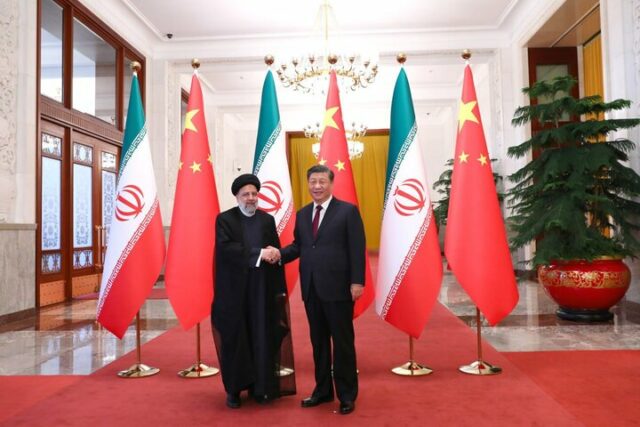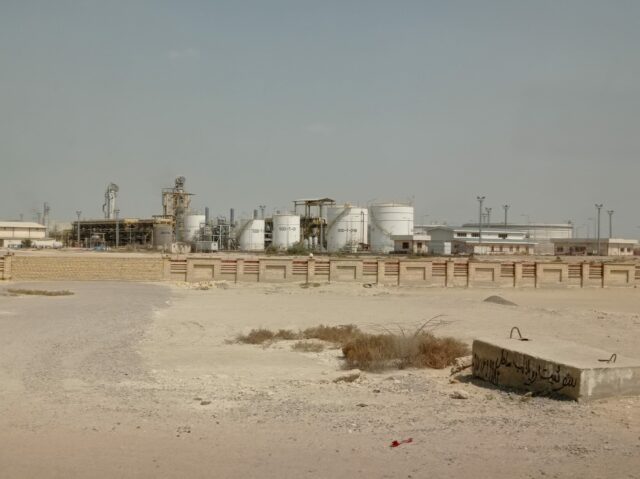Exploring Iran-China Cooperation: A Ground Report on the Persian Gulf Bridge

Persian Files ISSN 2975-0598 Volume 18 Issue 3
Author: Silvia Boltuc
Qeshm Island, renowned for its eroded phenomena and rich geological heritage, has held a prominent status among Iranian islands. Situated strategically within the Strait of Hormuz in the Persian Gulf, the island’s significance prompted the central government to establish a Free Economic Zone.
The construction of the Persian Gulf Bridge between Qeshm and the Iranian mainland stands out as a pivotal project showcasing the growing collaboration between Tehran and Beijing.
This on-site report aims to uncover the current status of exchanges between China and Iran, focusing on the potential advantages and outcomes linked to the construction of the Persian Gulf bridge.
Background Information
On the sidelines of the 23rd China International Investment and Trade Event (CIFIT 2023) in September 2023, a meeting was held with the presence of the Chairman and CEO of Qeshm Free Zone Organisation and the Chairman of the board of directors of Qeshm Investment and Development Company with the vice president and senior executives of the Chinese Xiamen Road & Bridge Construction Group. CIFIT focuses on nationality and internationality, investment negotiation and investment policy promotion, coordinated development of national and regional economy, as well as economic and trade exchanges.
At the exhibition, Tehran showcased financing opportunities for investors, business owners, and visitors. Iran’s pavilion focused on investment packages and platforms of 7 free zones: Anzali, Aras, Mako, Arvand, Chabahar, Qeshm and Kish. At the end of August 2023, 850 packages worth about 15 billion euros for investment in Iran’s free zones were ready to be presented to the investors in target countries, such as Armenia, Iraq and China.
The meeting took place to benefit from the expertise of one of China’s major companies specialising in constructing water structures. Moreover, it was arranged because of the geographical resemblance between Xiamen Island and the neighbouring Fujian province and Qeshm island and the mainland of Hormozgan Province. Indeed, the meeting aimed to support the Persian Gulf Comprehensive Network Plan.
This plan involves advancing Kaveh port, improving roads and railways, including the construction of four highway lanes from Kaveh port to the mainland, establishing a railway line between the mainland and Qeshm Island, all contingent upon the completion of a Persian Gulf Bridge. These initiatives are vital components of the country’s strategic south-north corridor projects.
Previously, several Iranian Free Zone officials visited China to explore cutting-edge engineering technologies and project management practices by examining one of the world’s largest bridges. This colossal bridge project, linking Shenzhen to Zhongshan, is currently underway and being executed by Poly Changda Engineering Company, a subsidiary of China Poly Group.
This extensive sea-crossing project involves the integration of bridges, islands, tunnels, and underwater channels. Previously, former President Mahmoud Ahmadinejad also suggested constructing a sub-sea tunnel in place of a bridge. However, this proposal was ultimately turned down due to its high costs, advanced technology requirements, and associated risks.
Through these meetings, Iran was seeking assistance from Chinese expertise to advance the development of such complex infrastructures.
Finally, on February 7th, 2023, implementing the national and strategic plan of the Persian Gulf bridge in Qeshm has been operationalised. Among the high-ranking representatives attending the event, there were Hojatullah Abdulmaleki, Secretary of the Free Zones High Council, the Chairman of the Civil Commission of Iran’s Parliament, and Parliamentarians of Hormozgan Province.
Qeshm, an island located in the Persian Gulf of Iran, holds the distinction of being the largest island in West Asia. Connecting the island to the mainland of Iran has been one of the long-standing dreams of the islanders.
Through the Persian bridge, the port of Kaveh, located on Qeshm island, opposite to the commercial port of Bandar Shahid Rajaee at Bandar Abbas, will be connected to the Iranian mainland. Alongside the bridge, 92 kilometers of highways and 86 kilometers of railways will be created and linked to the nationwide transportation lines in Iran.
Geopolitical Scenario: Iran-China Cooperation
During former President Hassan Rouhani’s tenure in 2021, Iran and China inked a 25-year cooperation pact covering economic, military, and security aspects. The Iranian Foreign Ministry confirmed in 2022 that the agreement had progressed to the implementation phase. Notably, both China and Iran are under different levels of United States sanctions.
Seyyed Reza Seyed Aghazadeh, Director General of the Asia-Pacific Office of the Organisation for Trade Development, addressed the commencement of the 25-year strategic and comprehensive cooperation agreement between Iran and China. He responded to skeptics of China by highlighting that with the activation of this strategic cooperation agreement, Iran could present its industrial and mining projects to Beijing, potentially attracting investors. This, in turn, could foster economic development, boost employment rates, and address Iran’s economic challenges.
Aghazadeh emphasised the significance of acknowledging China as the world’s second-largest economic power, projected by the International Monetary Fund to potentially become the world’s leading economic power in the coming years. He stressed that given the global trend of countries seeking collaboration with China, missing out on such opportunities would be detrimental to Iran and its future economic progress.
In response to concerns about China’s alleged debt-trap diplomacy, the head of the Iran-China Chamber of Commerce clarified Iran has no intention of selling its territory, such as Qeshm Island, to China.
China is actively seeking a secure and sustainable energy source to diversify its energy imports, aiming to mitigate the potential risks associated with US sanctions. Therefore, the proposed concept involves offering oil and gas in exchange for infrastructure development.
This strategy aims to facilitate the growth of Iran’s economy under sanctions by focusing on infrastructure advancement. It’s crucial to note that this defined form of cooperation with China does not involve granting land or soil to China.
While nuclear negotiations remain a priority for Iran, Tehran is shifting its foreign strategy towards Asia to seek economic relief. The current government has emphasised regionalism and integration within Eurasian transit, transport, and energy networks as key strategies to pursue. These goals align with the signed accord, which brings Iran into China’s Belt and Road Initiative, a multi-trillion-dollar infrastructure scheme intended to extend from East Asia to Europe.
Iran and China collaborate within a regional framework, as they are both participants in the Shanghai Cooperation Organisation (SCO) and BRICS. The Iranian city of Semnan is a founding member within the International Tourism Alliance of Silk Road Cities.
Furthermore, in 2022, the Iranian government granted permission for China to establish a Consulate General in Bandar Abbas, Hormozgan, located in southern Iran. Hormozgan has fostered extensive cooperation with China across diverse sectors, notably in maritime transport and shipbuilding.
Additionally, a considerable number of Chinese individuals reside and conduct business on Qeshm Island. It’s important to mention that Iran maintains three consular offices in distinct regions of China, specifically in Shanghai, Guangzhou, and Hong Kong.

Conclusion
The construction of the Persian Gulf Bridge plays a crucial role in advancing the International North-South Transport Corridor (INSTC) and in fostering comprehensive development across Qeshm Island in Southern Iran. The establishment of rail and road transport networks will lead to reduced costs and transit times for goods from Qeshm.
Indeed, the building of the Persian Gulf Bridge, made up of 2.4 kilometres, has long been deemed essential for the economic advancement of this region, particularly in bolstering tourism, the oil and gas sector, and facilitating transit activities.
Its primary role is to link Qeshm’s coastal routes to the country’s railway and road transportation network, facilitating connections with Central Asian transit and import-export activities. This national mega plan includes four lanes for cars, one lane for trains, emergency lanes, and pedestrian pathways.
The INSTC, spanning from the Caspian Sea and Central Asia to India and traversing the Strait of Hormuz, will include Qeshm island, thereby strengthening the Iranian Free Economic Zone situated in that area. Specifically, the Russian ports of Makhachkala and Astrakhan, along with the Kazakh port Aktau, Azerbaijan’s Baku port, are currently linked to the Iranian port of Anzali and its Anzali Industrial-Trade Zone in the Caspian Sea region.
Thanks to the Persian Gulf Bridge, Qeshm will be part of the domestic network of transit corridors linking the Caspian port of Anzali to Bandar Abbas and Chabahar on the Gulf of Oman.
Based on a study conducted several years ago, it was projected that after the bridge’s opening, the central region of the island could evolve into a gateway connecting to the mainland, potentially leading to an increased population. This could potentially draw tourists to the island through various avenues. Being the first geopark in Iran and the Middle East, Qeshm features remarkable geosites. Often referred to as the eroded land, it serves as the primary gateway for geotourism in Iran.
Moreover, with easy access to the international airport, an area next to Dolphin Bay has the potential to develop into an airport city. This city could cater to finance, banking, and hotel sectors, equipped with MICE (Meetings, Incentives, Conferences, and Exhibitions) facilities. Once the Persian Gulf Bridge is connected, indeed, MICE tourism facilities might be developed around Qeshm Airport. The number of domestic and international tourists would accordingly increase.
Establishing a connection with the mainland will support the growth of industries and local production as well, enabling the export of goods from this region. Major infrastructure projects, such as cargo ports and chemical plants, including LNG supply facilities, could be expanded or developed. These developments may attract foreign companies to invest in the island, supplementing the advantageous economic environment provided by the free zone.
In view of this, the 23rd China Trade and Investment Event (CIFIT 2023) was significant for the Iranian-Chinese cooperation, aiming to encourage Chinese investments and facilitate joint ventures abroad. Representatives from Qeshm Free Zone participated in the event, showcasing over 90 investment packages in logistics, oil, and energy sectors. Additionally, they highlighted industries like fisheries and tourism as part of their presentation.
China possesses the financial resources and expertise that Tehran requires. The establishment of a Chinese Consulate in Bandar Abbas signifies the robustness and promise of Iranian-Chinese collaboration. Even though Tehran remains open to welcoming investments from Western nations, the Iranian government is increasingly prioritising engagement in Eurasian markets and corridors. This shift involves advancing economic diplomacy in Central Asia, the Caspian Sea region, and the Caucasus.
Do you like SpecialEurasia reports and analyses? Has our groundbreaking research empowered you or your team? Now is your chance to be a part of our mission! Join us in advancing independent reporting and unlocking the secrets of Eurasia’s complex geopolitical landscape. Whether through a one-time contribution or a monthly/yearly donation, your support will fuel our relentless pursuit of knowledge and understanding. Together, let’s pave the way for a brighter future. DONATE NOW and secure your place in shaping the geopolitical narrative.
